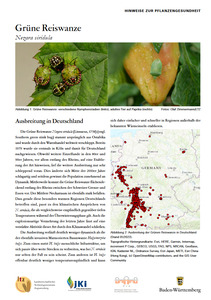{Tool} The southern green shield bug (Nezara viridula). [Grüne Reiswanze (Nezara viridula).] Creator(s): Zimmermann, Olaf; Reißig, Anna; Wendland, Sebastian and Dieckhoff, Christine. Issuing Organisation(s): LTZ - Landwirtschaftliches Technologiezentrum Augustenberg, JKI - Julius Kühn-Institut, PIK - Potsdam-Institut für Klimafolgenforschung. (2022)
|
PDF
- Published Version
- German/Deutsch
735kB | |
![[thumbnail of 2024-08-26 17_17_16-Grüne Reiswanze - Pflanzengesundheit_Grüne Reiswanze.pdf – Mozilla Firefox.png]](/54008/2.hassmallThumbnailVersion/2024-08-26%2017_17_16-Gr%C3%BCne%20Reiswanze%20-%20Pflanzengesundheit_Gr%C3%BCne%20Reiswanze.pdf%20%E2%80%93%20Mozilla%20Firefox.png)  Preview |
Image (PNG)
- Cover Image
- German/Deutsch
633kB |
Document available online at: https://ltz.landwirtschaft-bw.de/site/pbs-bw-mlr-root/get/documents_E-1797128667/MLR.LEL/PB5Documents/ltz_ka/Service/Schriftenreihen/Hinweise%20zur%20Pflanzengesundheit/Gr%C3%BCne%20Reiswanze_DL/Pflanzengesundheit_Gr%C3%BCne%20Reiswanze.pdf
Summary in the original language of the document
In this tool, you will learn more about the spread of the pest, its biology and how to identify its features and distinguish it from others. You will also learn about the hosts' range and what the damage looks like in the event of an infestation and how you can fight the pest, for example with natural enemies.
Summary translation
In diesem Tool erfahren Sie mehr über die Verbreitung des Käfers, seine Biologie, Erkennungsmerkmale und wie Sie ihn von anderen unterscheiden können, über das Wirtsspektrum und wie der Schaden im Falle eines Befalls aussieht und wie Sie ihn bekämpfen können, zum Beispiel mit natürlichen Feinden.
| EPrint Type: | Practice tool |
|---|---|
| Teaser: | A to Z about this pest |
| What problem does the tool address?: | The Southern Green Shield Bug originally comes from East Africa and was carried around the world through the trade in goods. It was first found in 1979 in Germany. Although further individual finds were made in the 1980s and 1990s, especially along the Rhine, there was evidence that the species was established, but further spread was progressing slowly. This changed suddenly in the mid-2010s and since then the population has been increasing. The Southern Green Shield Bug is now widespread along the Rhine between the Swiss border and Essen. The Middle Neckar region is also severely affected. That these particularly warm regions of Germany are affected, fits the climatic requirements of N. viridula, which is comparatively sensitive to low temperatures during the wintering phase. Explosive growth events in recent years further suggest increased activity of this species due to climate change. The spread is significantly less dynamic than that the also invasive marmorated stink bug Halyomorpha halys. On the one hand, H. halys uses human infrastructure to spread passively over long distances, which only rarely seems to be the case with N. viridula. On the other hand, H. halys is significantly less sensitive to temperature and can, therefore, move more easily and quickly to regions outside of the established known heat islands. |
| What solution does the tool offer?: | In order to successfully combat the pest, it is important to recognize it early and develop and learn effective methods of fighting it. |
| Country: | Germany |
| Type of Practice Tool: | Leaflets & guidelines |
| Keywords: | vegetables, temperate fruits, cereal crops, plant ptotection, pest control, biological control, natural enemies |
| Agrovoc keywords: | Language Value URI English vegetables http://aims.fao.org/aos/agrovoc/c_8174 English temperate fruits http://aims.fao.org/aos/agrovoc/c_7655 English cereal crops http://aims.fao.org/aos/agrovoc/c_25512 English plant protection http://aims.fao.org/aos/agrovoc/c_5978 English pest control http://aims.fao.org/aos/agrovoc/c_5726 English biological control http://aims.fao.org/aos/agrovoc/c_918 English natural enemies http://aims.fao.org/aos/agrovoc/c_5085 |
| Subjects: | Crop husbandry > Production systems > Cereals, pulses and oilseeds Crop husbandry > Production systems > Vegetables Crop husbandry > Production systems > Fruit and berries Crop husbandry > Crop health, quality, protection Crop husbandry > Production systems > Ornamentals, flower bulbs and tree nurseries |
| Research affiliation: | Germany > Federal Agency for Agriculture and Food - BLE Germany > Federal Research Centre for Cultivated Plants - JKI European Union > Horizon Europe > OrganicAdviceNetwork > selected tools European Union > Organic Farm Knowledge |
| Horizon Europe or H2020 Grant Agreement Number: | 101060368 |
| Related Links: | https://organic-farmknowledge.org/tool/54008, https://organic-farmknowledge.org/tool/54007, https://organic-farmknowledge.org/tool/44300, https://organic-farmknowledge.org/tool/53626 |
| Project ID: | OFK |
| Deposited By: | Rüger, Madelaine Lea |
| ID Code: | 54008 |
| Deposited On: | 29 Aug 2024 07:46 |
| Last Modified: | 14 Mar 2025 15:04 |
| Document Language: | German/Deutsch |
| Status: | Published |
Repository Staff Only: item control page

 Download Statistics
Download Statistics Download Statistics
Download Statistics
